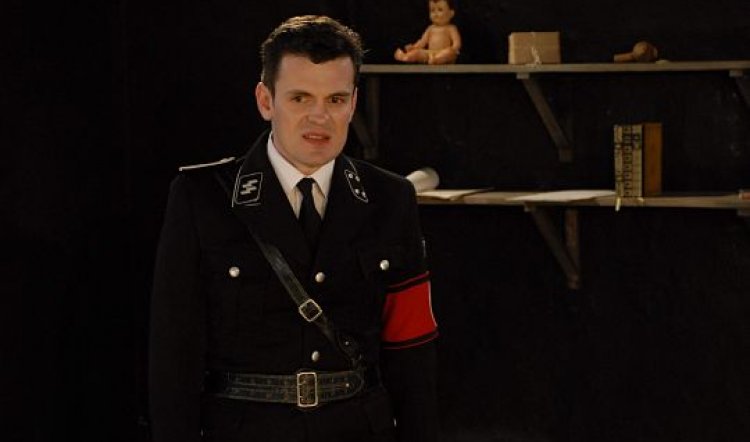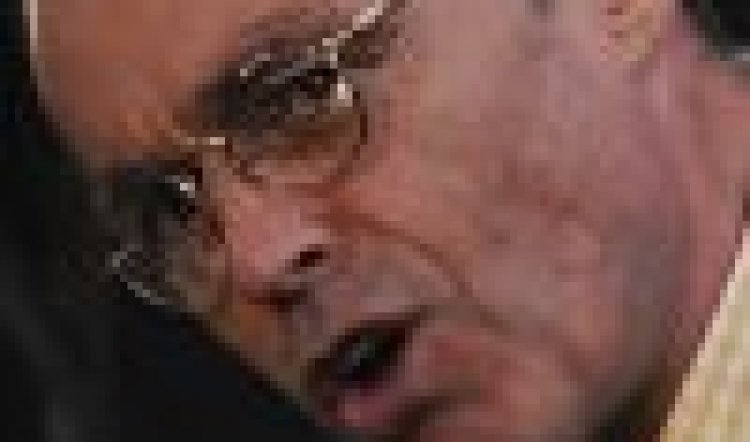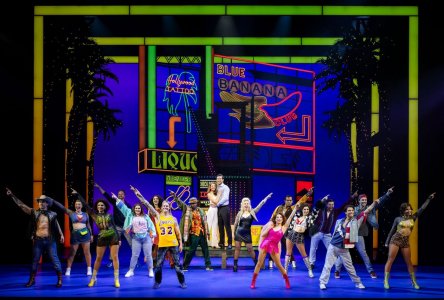
Way to Heaven
WAY TO HEAVEN Ride On Theatre & Griffin Independent, SBW Stables Theatre; 16 April-May 8, 2010; images Heidrun Lohr.
NICHOLAS HOPE opens this first Australian production of Juan Mayorga’s most recent play in a minimal yet disturbing fashion, delivering a monologue in a halting, nervous way, more or less into a microphone, and more or less to the audience. This audience is already disturbed by being (politely) treated like cattle and so it doesn’t take long for the idea of the cruelly polite reality of Theresienstadt and its ilk to sink in.
Translated from the Spanish by David Johnson the play’s title refers to the German “Himmelweg” – in this context describing the conduit leading to the gas chambers at Treblinka. In the play it’s borrowed for the camp Commandant (Nathan Lovejoy) who, with a warm smile, tells Hope’s visiting Red Cross worker, “The path between the infirmary and the train, we call it ‘the way to heaven’.” The term “infirmary” is yet another of the euphemisms so merrily used by the Nazis. In Theresienstadt, to this day, there is an equally chilling and cynical motto over one of its gateways: “Arbeit macht frei” – “work makes you free”. A favourite exhortation of the Nazis, it can also be seen at Dachau and Auschwitz.
In other words, Mayorga’s setting is not named but is an unmistakable amalgam of the vilest concepts in the Nazis program and plans for Jewish extermination. The model village facade hides an extermination camp; not only model, but intended for the flower of Jewish society – artists, writers, actors, musicians and so on – where they must perform for their lives; or at least for a little extra time. If this sounds familiar, think Fania Fenelon, leader of the camp orchestra in Auschwitz.
In Way To Heaven, Mayorga also plays with the concept of playing itself. The Red Cross worker visits in 1942 and semi-willingly buys the fiction of the children happily playing, the couple happily canoodling, an orchestra happily playing in an otherwise deserted square and an equally deserted railway station where the clock tells a permanent fiction of six o’clock. He could have done something, he tells us. He should have done something. Ah yes, but he didn’t. And in the acts that follow, these fictions are restaged and replayed from various points of view as if to tease and torment the memory, the truth and the hapless players.
The village “mayor” Gershom Gottfried (Terry Serio) is at once victim and accomplice of the Commandant as he is urged to play his part in the farrago of guiding the Red Cross visitor around the showpiece. “Take photographs,” the visitor is entreated, “Feel free to take photographs.” But, as we already know from the Red Cross visitor’s anguished confession in the opening scene, he now knows those photographs were used as part of the lie being told. And in real lift these have come down to us as evidence of the Nazis’ duplicity in committing their heinous crimes.

It’s an intriguing idea and the play’s language and structure are equally interesting: episodic and desultory, detached and matter-of-factly poetic by turn. This distancing effect is possibly more effective in these Holocaust-saturated times than a more tightly focused and emotionally charged style; nevertheless, whether or not the playwright intended it to be quite as remote and disjointed as this production, directed by Tanya Goldberg, is open to question.
Designer Simone Romaniuk places the action in an uneasy, dark abstract space where the only distraction for the eye is glinting blue metal, in drifts and small piles, at the outer edges; and a water trough that serves as any number of shiver-provoking ideas, depending on the viewer’s imagination. Costume Designer Xanthe Heubel clothes the characters – adults, children and the Commandant – in solid evocations of the 1940s, while Verity Hampson lights the action, and the audience, in unsettling and relentless fashion. Indeed, in this production, the creatives are rather more successful in their roles than the actors, with the exception of Hope, Lovejoy and Serio, all splendid. The others seem not to have a firm grasp on who they are and why; and given the structure and writing, it means they’re not the only ones who appear to be lost.
The two enduring images of the play are the Commandant’s insistence to a bewildered Gershom Gottfried that it is he – the German – who is the most civilized among them, with his shelves of Shakespeare, Calderon, Spinoza and his love of fine music. Later, however, at his insistence, Gottfried coaches the children in their “lines” as they listen to the sound of trains – the ones the Commandant insists do not come to the camp. “If we do it well,” Gottfried coaxes tenderly, “We’ll see mummy again, on one of those trains.”


-c444x300.jpeg)
